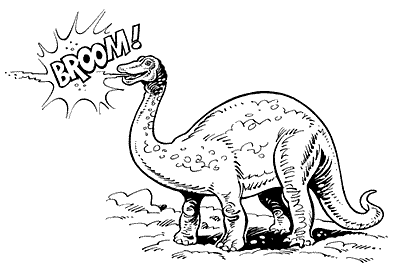sauro-, saur-, -saurus, -saurid, -saur,
-sauria, -saurian +
(Greek: lizard, reptile, serpent; used especially with reference to "dinosaurs")
Aachenosaurus
Aachenosaurus was found and named in 1888, by the scientist Gerard Smets who named the species Aachenosaurus multidens, to what was believed to be two hadrosaurian (duck-billed dinosaur) fragments. Later that year the specimens proved to be pieces of petrified wood.

Smets at first tried to defend his original identification, but he was proven to be wrong by a neutral commission and so it is reported that he withdrew from scientific research completely because of his humiliation or mortification.

Dinosaurs came in all shapes and sizes and many of the "scientific" conceptions about them are essentially guesswork or estimations.
Abelisaurus
An “Abel lizard” from Late Cretaceous Argentina. Named in honor of Roberto Abel, director of the Museo de Cipolletti, Cipolletti, Argentina, who discovered the fossil. Named by Argentinian paleontologists José F. Bonaparte and Fernando E. Novas, in 1985.
Abrictosaurus
An “awake (wakeful) lizard” from Early Triassic Lesotho, Africa. Named by paleontologist James A. Hopson in 1975.
Achelousaurus, Achelosaurus
An “Achelous lizard” from Late Cretaceous North America (Montana). It was named after the Greek, Akheloos, a mythical river god who could change shape at will. He transformed himself into a bull to fight Hercules, who defeated Achelous by tearing off one of his horns. The name alludes to the way a large hornless dinosaur apparently evolved from earlier horned ancestors. Named by Scott Matthew Sampson in 1995.
Acompsosaurus
A “sturdy lizard” from Late Triassic. Its name comes from Greek akompsos, “not delicate, unadorned”. Named by M. G. Mehl in 1915.
A genus of carcharodontosaurid dinosaur, meaning "high-spined lizard": The Acrocanthosaurus existed in Oklahoma, Utah, and Texas during the Early Cretaceous time. It was named by U.S paleotologists John Willis Stovall and Wann Langston, Jr. in 1950.
Adasaurus
“Ada’s lizard” (an evil spirit from Mongolian mythology) from Early (or some say Late) Cretaceous southern Mongolia. Named by Mongolian paleontologist Rinchen Barsbold in 1983.
Aegyptosaurus
An “Egyptian lizard” from Middle or Late Cretaceous rocks of the Sahara desert in Egypt. Named by German paleontologist Ernst Stromer von Reichenbach in 1932.
Aeolotosaurus
A “wind lizard” from Late Cretaceous (windy) Patagonian region of southern Argenina. It was named for Aeolus, god of the winds in Greek and Roman mythology. Named by Jaime Eduardo Powell in 1988.
Aepisaurus
An “elephant lizard” from Early Cretaceous rocks of southern France. The name comes from Greek, aipys, “high, lofty”. Named by François Louis Paul Gervais in 1853.
Aetosaurus, Aetosaurs
An “eagle lizard” from Late Triassic to Early Jurassic southern Africa. Its name, “eagle (skull) lizard”, comes from Greek, aetos, “eagle”. Some modern sources incorrectly indicate that Aetosaurus is derived from the Latin aetas, “age”, and supposedly means “old lizard”.
An agile (nimble) lizard from Middle Jurassic Dashanpu Quarry in Sichuan, China: Agilisaurus got its name because it is believed to have been agile as indicated by the light structure of the skeleton and the ratios of its limbs. It was named by Peng Guangzhao in 1992.
Agrosaurus (s) (proper noun)
An extinct genus meaning "wild country" or "field lizard": The thecodontosaurid sauropodomorph of the non-existent genus Agrosaurus probably originated in England, but actually was thought to be a Triassic prosauropod from Australia.
Agrosaurus is supposed to be the oldest dinosaur from Australia.
Alamosaurus
“Alamo lizard” from Late Cretaceous New Mexico, Utah, Texas, and Montana (USA). The Alamosaurus was named for the Ojo Alamo (“poplar tree”) trading post (and/or a spring) in New Mexico, not the Alamo in San Antonio, Texas. Named by U. S. paleontologist Charles Whitney Gilmore in 1922.
Albertosaurus
"Alberta lizard" from Late Cretaceous Alberta, Canada and Montana, USA. It was named for Prince Albert, consort to Queen Victoria. This creature was formerly known as Deinodon and Gorgosaurus. Named by U. S. paleontologist Henry Fairfield Osborn in 1905.

